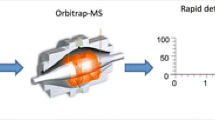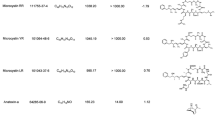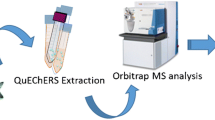Abstract
During the last decade, a significant increase in the occurrence of harmful algal blooms (HABs), linked to repetitive cases of shellfish contamination has become a public health concern and therefore, accurate methods to detect marine toxins in different matrices are required. In this study, we developed a method for profiling lipophilic marine microalgal toxins based on ultra-high-performance liquid chromatography coupled to high-resolution Orbitrap mass spectrometry (UHPLC-HR-Orbitrap MS). Extraction of selected toxins (okadaic acid (OA), dinophysistoxin-1 (DTX-1), pectenotoxin-2 (PTX-2), azaspiracid-1 (AZA-1), yessotoxin (YTX) and 13-desmethyl spirolide C (SPX-1)) was optimized using a Plackett-Burman design. Three key algal species, i.e., Prorocentrum lima, Protoceratium reticulatum and Alexandrium ostenfeldii were used to test the extraction efficiency of OA, YTXs and SPXs, respectively. Prorocentrum micans, fortified with certified reference solutions, was used for recovery studies. The quantitative and confirmatory performance of the method was evaluated according to CD 2002/657/EC. Limits of detection and quantification ranged between 0.006 and 0.050 ng mL−1 and 0.018 to 0.227 ng mL−1, respectively. The intra-laboratory reproducibility ranged from 6.8 to 11.7 %, repeatability from 6.41 to 11.5 % and mean corrected recoveries from 81.9 to 119.6 %. In addition, algae cultures were retrospectively screened for analogues and metabolites through a homemade database. Using the ToxID software programme, 18 toxin derivates were detected in the extract of three toxin producing microalgae species. In conclusion, the generic extraction and full-scan HRMS approach offers an excellent quantitative performance and simultaneously allows to profile analogues and metabolites of marine toxins in microalgae.

Optimization of extraction, detection and quantification of lipophilic marine toxins in microalgae by UHPLC-HR Orbitrap MS




Similar content being viewed by others
References
Hinder S, Brooks G, Hays C, Davies A, Edwards M, Walne A, Gravenor M (2011) Toxic marine microalgae and shellfish poisoning in the British isles: history, review of epidemiology, and future implications. Environ Health 10:54–66
Hallegraeff GM (2010) Ocean climate change, phytoplankton community responses, and harmful algal blooms: a formidable predictive challenge. J Phycol 46:220–235
James KJ, Carey B, O'Halloran J, Van Pelt F, Skrabakova Z (2010) Shellfish toxicity: human health implications of marine algal toxins. Epidemiol Infect 138:927–940
Tirado MC, Clarke R, Jaykus LA, Mcquatters-Gollop A, Frank JM (2010) Climate change and food safety: a review. Food Res Int 43:1745–1765
Park TG, Lim WA, Park YT, Lee CK, Jeong HJ (2013) Economic impact, management and mitigation of red tides in Korea. Harmful algae 30S:S131–S143
Fux E, Smith JL, Tong MM, Guzman L, Anderson DM (2011) Toxin profiles of five geographical isolates of Dinophysis spp. from North and South America. Toxicon 57:275–287
Nielsen LT, Krock B, Hansen PJ (2012) Effects of light and food availability on toxin production, growth and photosynthesis in Dinophysis acuminata. Mar Ecol Prog Ser 471:37–50
Nielsen LT, Krock B, Hansen PJ (2013) Production and excretion of okadaic acid, pectenotoxin-2 and a novel dinophysistoxin from the DSP-causing marine dinoflagellate Dinophysis acuta—effects of light, food availability and growth phase. Harmful Algae 23:34–45
Caillaud A, de la Iglesia P, Campás M, Elandaloussi L, Fernández M, Mohammad-Noor N, Andree K, Diogéne J (2010) Evidence of okadaic acid production in a cultures strain of the marine dinoflagellate Prorocentrum rhathymum from Malaysia. Toxicon 55:633–637
López Rosales L, Gallardo Rodríguez JJ, Sánchez Mirón A, Cerón García MC, Belarbi EH, García Camacho F, Molina Grima E (2014) Simultaneous effects of temperature and irradiance on growth and okadaic acid production from the marine dinoflagellate Prorocentrum belizeanum. Toxicon 6:229–253
Gallardo Rodríguez JJ, Sánchez Mirón A, Garcia Camacho F, Cerón García MC, Belarbi EH, Molina Grima E (2010) Culture of dinoflagellate in a fed-batch and continuous stirred-tank photobioreactors: growth, oxidative stress and toxin production. Process Biochem 45:660–666
Röder K, Hantzsche FM, Gebühr C, Miene C, Helbig T, Krock B, Hoppenrath M, Luckas B, Gerdts G (2012) Effects of salinity, temperature and nutrients on rowth, cellular characteristics and yessottoxin production of Protoceratium reticulatum. Harmful Algae 15:59–70
Tillmann U, Elbrachter M, John U, Krock B, Cembella A (2010) Azadinium obesum (Dinophyceae), a new nontoxic species in the genus that can produce azaspiracid toxins. Phycologia 49:303–303
Salas R, Tillmann U, John U, Kilcoyne J, Burson A, Cantwell C, Hess P, Jauffrais T, Silke J (2011) The role of Azadinium spinosum (Dinophyceae) in the production of azaspiracid shellfish poisoning in mussels. Harmful Algae 10:774–783
Gerssen A, Mulder PPJ, de Boer J (2011) Screening of lipophilic marine toxins in shellfish and algae: development of a library using liquid chromatography couple to orbitrap mass spectrometry. Anal Chim Acta 685:176–185
Rundberget T, Bunaes Aasen JA, Selwood AI, Miles CO (2011) Pinnatoxins and spirolides in Norwegian blue mussels and seawater. Toxicon 58:700–711
Lee KJ, Mok JS, Song KC, Yu H, Lee DS, Jung JH, Kim JH (2012) First detection and seasonal variation of lipophilic toxins okadaic acid, dinophysistoxin-1, and yessotoxin in Korean gastropods. J Food Prot 75:2000–2006
Lopes VM, Lopes AR, Costa P, Rosa R (2013) Cephalopods as vectors of harmful algal blooms toxins in marine food webs. Mar Drugs 11:3381–3409
Valdiglesias V, Prego-Faraldo MV, Pásaro E, Méndez J, Laffon B (2013) Okadaic acid: more than a diarrheic toxin. Mar Drugs 11:4328–4349
Van Dolah F (2000) Marine algal toxins: Origins, health effects, and their increased occurrence. Environ Health Perspect 108:133–141
Anon (2004) Regulation (EC) No 853/2004 of the European Parliament and of the Council of 29 April 2004 laying down specific hygiene rules for food of animal origin. Offic. J. European Union, L139. Section VII, Chapter V. 60–61
Anon (2005) Regulation (EC) No 2074/2005 of the European Parliament and of the Council of 5 December 2005 laying down implementing measures of certain products under Regulation (EC) No 835/2004 of the European Parliament and of the Council and for the organisation of official controls under Regulation (EC) No 854/2004 of the European Parliament and of the Council and Regulation (EC) No 882/200 of the European Parliament and of the Council, derogating from Regulation (EC) No 852/2004 of the European Parliament and of the Council and amending Regulations (EC) No 853/2004 and (EC) No 854/2004. Official Journal of the European Union L338. Annex III, Chapter III. pp 40–41
Domènech A, Cortés-Francisco N, Palacios O, Franco JM, Riobó P, Llerena JJ, Vichi S, Caixach J (2014) Determination of lipophilic marine toxins in mussels. Quantification and confirmation criteria using high resolution mass spectrometry. J Chromatogr A 1328:16–25
García-Altares M, Casanueva A, Bane V, Diogéne J, Furey A, de la Igleasia P (2014) Confirmation of pinnatoxins and spirolides in shellfish and passive samplers from Catalonia (Spain) by liquid chromatography coupled with triple quadrupole and high-resolution hybrid tamdem mass spectrometry. Mar Drugs 12:3706–3732
Orellana G, Vande bussche J, Van Meulebroek L, Vandegehuchte M, Janssen C, Vanhaecke L (2014) Validation of a confirmatory method for lipophilic marine toxins in shellfish using UHPLC-HR-Orbitrap MS. Anal Bional Chem 1618
Van Meulebroeck L, Vanden Bussche J, Steppe K, Vanhaecke L (2012) Ultra-high performance liquid chromatography couple to high resolution Orbitrap mass spectrometry for metabolomic profiling of the endogenous phytohormonal status of the tomato plant. J Chromatogr A 1260:67–80
De la Iglesia P, Fernandez-Tejedor M (2013) An analytical perspective on detection, screening, and confirmation in phycology, with particular reference to toxins and toxin-producing species. J Phycol 49:1056–1060
Jauffrais T, Herrenknecht C, Séchet V, Sibat M, Tillmann U, Krock B, Kilcoyne J, Milles CO, McCarron P, Amzil Z, Milles CO, Hess P (2012) Quantitative analysis of azaspiracids in Azadinium spinosum cultures. Anal Bional Chem 403:833–846
Guillard RRL, Hargraves PE (1993) Stichochrysis immobilis is a diatom, not a chrysophyte. Phycologia 32:234–236
Plackett RL, Burman JP (1964) The design of optimum multifactorial experiments. Biometrika 33:305
Beres DL, Hawkins DM (2001) Plackett-Bruman technique for sensitivity analysis of many-parametered models. Ecol Model 141:171
Bezerra ML, Santelli RE, Oliveira EP, Villar LS, Escaleira LA (2008) Response surface methodology (RSM) as a tool for optimization in analytical chemistry. Talanta 76:965–977
Hackett JD, Mengmeng T, Kulis DM, Fux E, Hess P, Bire R, Anderson M (2009) DSP toxin production de novo in cultures of Dinophysis acuminata (Dinophyceae) from North America. Harmful Algae 8:873–879
Paz B, Riobó P, Franco JM (2011) Preliminary study for rapid determination of phycotoxins in microalgae whole cells using matrix-assisted laser desorption/ ionization time-of-flight mass spectrometry. Rapid Commun Mass Spectrom 25:3627–3639
Anastácio A, Carvalho IS (2013) Phenolics extraction from sweet potato peels, key factors screening through a Plackett-Burman design. Ind Crop Prod 43:99–105
Commissions Decision 2002/657/EC (2002) Implementing Council Directive 96/23/EC concerning the performance of analytical methods and the interpretation of results. Off J Eur Commun L221:8–36
Antignac JP, Le Bizec B, Monteau F, Andre F (2003) Validation of analytical methods based on mass spectrometric detection according to the “2002/657/EC” European decision: guideline and application. Anal Chim Acta 483:325–334
Reguera B, Velo-Suárez L, Raine R, Park MG (2012) Harmful Dinophysis species: a review. Harmful Algae 14:87–106
Diaz P, Reguera B, Ruiz-Villarreal M, Pazos Y, Velo-Suárez L, Berger H, Sourisseau M (2013) Climate variability and oceanographic settings associated with interannual variability in the initiation of Dinophysis acuminata blooms. Mar Drugs 11:2964–2981
Aasen J, Sambal IA, Miles CO, Dahl E, Briggs LR, Aune T (2005) Yessotoxins in Norwegian blue mussels (Mytilus edulis): uptake from Proroceratium reticulatum, metabolism and depuration. Toxicon 45:265–272
Nascimento SM, Purdie DA, Morris S (2005) Morphology, toxin composition and pigment content of Prorocentrum lima strains isolated from a coastal lagoon in southern UK. Toxicon 45:633–649
Fux E, Gonzalez-GIL S, Lunven M, Gentien P, Hess P (2010) Production of diarrhetic shellfish poisoning toxins and pectenotoxins at depths within and below the euphotic zone. Toxicon 56:1487–1496
Ciminiello P, Dell’Avellano C, Forino M, Tartaglione L (2014) Marine toxins in Italy: the more you look, the more you find. Eur J Org Chem 1357–1369
Medhioub W, Sechet V, Truquet P, Bardouil M, Amzil Z, Lassus P, Soudant P (2011) Alexandrium ostenfeldii growth and spirolide production in batch culture and photobioreactor. Harmful algae 10:794–803
Karnes HT, March C (1991) Calibration and validation of linearity in chromatographic biopharmaceutical analysis. J Pharm Biomed 9:911–918
Vale P, Veloso V, Amorim A (2009) Toxin composition of a Prorocentrum lima strain isolated from the Portuguese coast. Toxicon 54:145–152
Li J, Li M, Pan J, Liang J, Zhou Y, Wu J (2012) Identification of the okadaic acid-based toxin profile of a marine dinoflagellate strain Prorocentrum lima by LC-MS/MS and NMR spectroscopic data. J Sep Sci 35:782–789
Paz B, Blanco J, Franco JM (2013) Yessotoxins production during the culture of Protoceratium reticulatum strains isolated from Galician Rias Baixas (NW Spaian). Harmful Algae 21–22:13–19
Ciminiello P, Dell’ Aversano C, Fattorusso E, Magno S, Tartaglione L, Cangini M, Pompei M, Guerrini F, Boni L, Pistocchi R (2006) Toxin profile of Alexandrium ostenfeldii (Dinophyceae) from the North Adriatic Sea revealed by liquid chromatography-mass spectrometry. Toxicon 47:597–604
Cruz PG, Daranas AH, Fernández JJ, Souto ML, Norte M (2006) DTX5c, a new OA sulphate ester derivative from cultures of Prorocentrum belizeanum. Toxicon 47:920–924
Paz B, Daranas AH, Cruz PG, Franco JM, Norte M, Fernández JJ (2008) Identification of 19-epi-okadaic acid, a new diarrhetic shellfish poisoning toxin, by liquid chromatography with mass spectrometry detection. Mar Drugs 6:489–495
Britton R, Roberge M, Brown C, Van Soest R, Andersen RJ (2003) New okadaic acid analogues from the marine sponge Merriamum oxeato and their effect on mitosis. J Nat Prod 66:838–843
Paz B, Daranas AH, Cruz PG, Franco JM, Pizarro G, Souto ML, Norte M, Fernández JJ (2007) Characterization of okadaic acid related toxins by liquid chromatography coupled with mass spectrometry. Toxicon 50:225–235
Miles CO, Samdal IA, Aasen JAG, Jensen DJ, Quilliam MA, Petersen D, Briggs LM, Wilkins AL, Rise F, Cooney JM, MacKenzie AL (2005) Evidence for numerous analogs of yessotoxins in Protoceratium reticulatum. Harmful Algae 4:1075–1091
Hu T, Burton IW, Cembella AD, Curtis JM, Quilliam MA, Walter JA, Wright JLC (2001) Characterization of spirolide a, b, and 13-desmethyl C, new marine toxins isolated from toxic plankton and contaminated shellfish. J Nat Prod 64:308–312
Sleno L, Windust AJ, Volmer DA (2004) Structural study of spirolide marine toxins by mass spectrometry. Anal Bional Chem 378:969–976
Hu T, Curtis JM, Walter JA, Wright JLC (1996) Characterization of biologically inactive spirolide E and F: identification of the spirolide pharmacophore. Tetrahedron Lett 37:7671–7674
MacKinnon S, Walter J, Quilliam M, Cembella A, LeBlanc P, Burton I, Hardstaff W, Lewis N (2006) Spirolides isolated from Danish strains of the toxigenic dinoflagellate Alexandrium ostenfeldii. J Nat Prod 69:8–12
Roach JS, LeBlanc P, Lewis NI, Munday R, Quilliam MA, MacKinnon SL (2009) Characterization of a dispiroketal spirolide subclass from Alexandrium ostenfeldii. J Nat Prod 72:1237–1240
Ciminiello P, Dell’ Aversano C, Fattorusso E, Forino M, Grauso L, Tartaglione L, Guerrini F, Pistocchi R (2007) Spirolide toxin profile of adriatic Alexandrium ostenfeldii cultures and structure elucidation of 27-hydroxy-13,19-didesmethyl spirolide C. J Nat Prod 70:1878–1883
Ciminiello P, Dell’ Aversano C, Iacovo ED, Fattorusso E, Forino M, Grauso L, Tartaglione L, Guerrini F, Pezzolesi L, Pistocchi R (2010) Characterization of 27-hydroxy-13-desmethyl spirolide C and 27-oxo-13,19-didesmethyl spirolide C. Further insights into the complex Adriatic Alexandrium ostenfeldii toxin profile. Toxicon 56:1327–1333
Aasen J, Hardstaff W, Aune T, Quilliam MA (2006) Discovery of fatty acid ester metabolites of spirolide toxins in mussels from Norway using liquid chromatography/tandem mass spectrometry. Rapid Commun Mass Spectrom 20:1531–1537
Commission Decision 96/23/EC (1996) On measures to monitor certain substances and residues thereof in live animals and animal products and repealing Directives 85/385/EEC and 86/469/EEC and decision 89/187/EEC and 91/664/EEC. Off J Eur Commun L125:10
Vanhaecke L, Van Meulebroek L, De Clercq N, Vanden Bussche J (2013) High resolution orbitrap mass spectrometry in comparison with tandem mass spectrometry for confirmation of anabolic steroids in meat. Anal Chim Acta 767:118–127
Lehner SM, Neumann NKN, Sulyok M, Lemmens M, Krska R, Schuhmacher R (2011) Evaluation of LC-high-resolution FT-Orbitrap MS for the quantification of selected mycotoxins and the simultaneous screening of fungal metabolites in food. Food Addit Contam 28:1457–1468
Stoev G, Xuan Y, Peycheva M, Scigelova M (2012) Quantitative assessment of the contribution of high resolution mass spectrometry analysis to the reliability of compound confirmation. Talanta 98:19–27
Dahlmann J, Budakowski WR, Luckas B (2003) Liquid chromatography–electrospray ionisation-mass spectrometry based method for the simultaneous determination of algal and cyanobacterial toxins in phytoplankton from marine waters and lakes followed by tentative structural elucidation of microcystins. J Chromatogr A 994:45–57
Acknowledgments
The authors wish to thank Mieke Naessens, Ine Opsteyn, Dirk Stockx, Nancy De Saeyer, Marc Vanderborght, Julie Kiebooms and Nathalie De Clercq for their technical contribution to this manuscript.
Author information
Authors and Affiliations
Corresponding author
Additional information
Published in the topical collection High-Resolution Mass Spectrometry in Food and Environmental Analysis with guest editor Aldo Laganà.
Electronic supplementary material
Below is the link to the electronic supplementary material.
ESM 1
(PDF 47.7 kb)
Rights and permissions
About this article
Cite this article
Orellana, G., Van Meulebroek, L., Van Vooren, S. et al. Quantification and profiling of lipophilic marine toxins in microalgae by UHPLC coupled to high-resolution orbitrap mass spectrometry. Anal Bioanal Chem 407, 6345–6356 (2015). https://doi.org/10.1007/s00216-015-8637-y
Received:
Revised:
Accepted:
Published:
Issue Date:
DOI: https://doi.org/10.1007/s00216-015-8637-y




